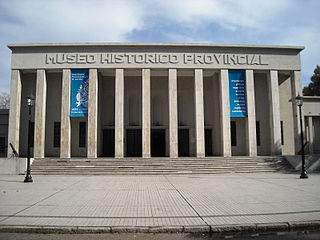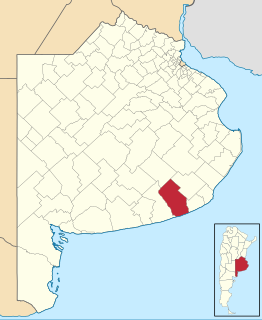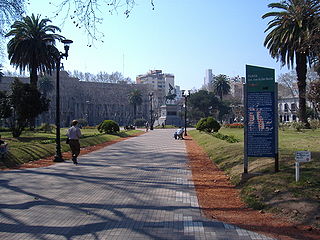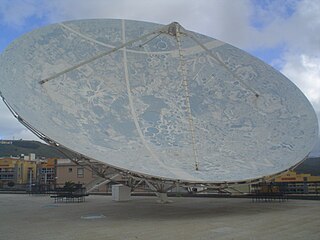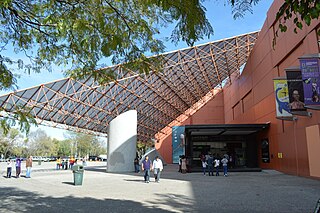The Dr. Ángel Gallardo Provincial Natural Sciences Museum (in Spanish, Museo Provincial de Ciencias Naturales Dr. Ángel Gallardo) is a public museum in Rosario, Argentina, specialized in biology. It was founded by Professor Pascual Maciá (a professor and zoologist) in 1945, and is currently administered by the provincial state of Santa Fe. [1]

Argentina, officially the Argentine Republic, is a country located mostly in the southern half of South America. Sharing the bulk of the Southern Cone with Chile to the west, the country is also bordered by Bolivia and Paraguay to the north, Brazil to the northeast, Uruguay and the South Atlantic Ocean to the east, and the Drake Passage to the south. With a mainland area of 2,780,400 km2 (1,073,500 sq mi), Argentina is the eighth-largest country in the world, the fourth largest in the Americas, and the largest Spanish-speaking nation. The sovereign state is subdivided into twenty-three provinces and one autonomous city, Buenos Aires, which is the federal capital of the nation as decided by Congress. The provinces and the capital have their own constitutions, but exist under a federal system. Argentina claims sovereignty over part of Antarctica, the Falkland Islands, and South Georgia and the South Sandwich Islands.
Biology is the natural science that studies life and living organisms, including their physical structure, chemical processes, molecular interactions, physiological mechanisms, development and evolution. Despite the complexity of the science, there are certain unifying concepts that consolidate it into a single, coherent field. Biology recognizes the cell as the basic unit of life, genes as the basic unit of heredity, and evolution as the engine that propels the creation and extinction of species. Living organisms are open systems that survive by transforming energy and decreasing their local entropy to maintain a stable and vital condition defined as homeostasis.
Zoology is the branch of biology that studies the animal kingdom, including the structure, embryology, evolution, classification, habits, and distribution of all animals, both living and extinct, and how they interact with their ecosystems. The term is derived from Ancient Greek ζῷον, zōion, i.e. "animal" and λόγος, logos, i.e. "knowledge, study".
The museum was formerly located in the National University of Rosario Law School (a national historic monument built in 1889). On July 1, 2003, people attending a demonstration organized by labor unions launched fireworks and other pyrotechnic devices to attract attention, near the building. A fire broke out, forcing its evacuation. The fire damaged or destroyed around 50% of the facilities, including 80% of the museum (with the loss of 11,000 of its 13,000 exhibits). [2]

The National University of Rosario is a research public university located in the city of Rosario, province of Santa Fe, Argentina.
The Facultad de Derecho is the Law School of the National University of Rosario (Argentina), and is located in the former Palace of Justice Building, a Rosario landmark and a National Historic Monument.
The reconstruction of the museum required around 2 million pesos (US$660,000). The remaining exhibits were restored, and the seat of the museum was moved one block, to the building that houses the delegation of the provincial government. The museum was re-inaugurated on July 6, 2006, downsized, with a more modern concept including interactive displays. [3]

The peso is the currency of Argentina, identified by the symbol $ preceding the amount in the same way as many countries using dollar currencies. It is subdivided into 100 centavos. Its ISO 4217 code is ARS.

The United States dollar is the official currency of the United States and its territories per the United States Constitution since 1792. In practice, the dollar is divided into 100 smaller cent (¢) units, but is occasionally divided into 1000 mills (₥) for accounting. The circulating paper money consists of Federal Reserve Notes that are denominated in United States dollars.




